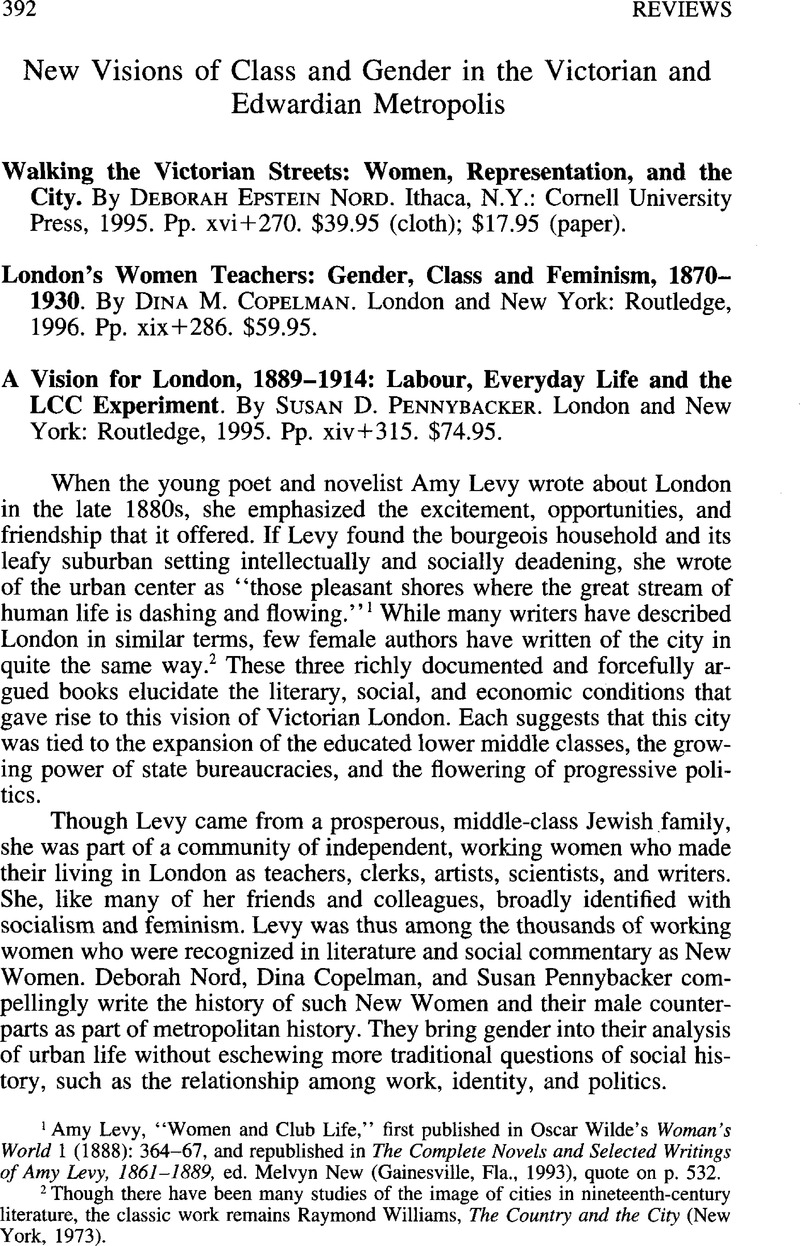No CrossRef data available.
Article contents
New Visions of Class and Gender in the Victorian and Edwardian Metropolis - Walking the Victorian Streets: Women, Representation, and the City. By Deborah Epstein Nord. Ithaca, N.Y.: Cornell University Press, 1995. Pp. xvi + 270. $39.95 (cloth); $17.95 (paper). - London's Women Teachers: Gender, Class and Feminism, 1870–1930. By Dina M. Copelman. London and New York: Routledge, 1996. Pp. xix + 286. $59.95. - A Vision for London, 1889–1914: Labour, Everyday Life and the LCC Experiment. By Susan D. Pennybacker. London and New York: Routledge, 1995. Pp. xiv + 315. $74.95.
Published online by Cambridge University Press: 10 January 2014
Abstract

- Type
- Reviews
- Information
- Journal of British Studies , Volume 38 , Issue 3: Masculinity and the Lower Middle Class , July 1999 , pp. 392 - 398
- Copyright
- Copyright © North American Conference of British Studies 1999
References
1 Amy Levy, “Women and Club Life,” first published in Wilde's, OscarWoman's World 1 (1888): 364–67Google Scholar, and republished in The Complete Novels and Selected Writings of Amy Levy, 1861–1889, ed. New, Melvyn (Gainesville, Fla., 1993), quote on p. 532Google Scholar.
2 Though there have been many studies of the image of cities in nineteenth-century literature, the classic work remains Williams, Raymond, The Country and the City (New York, 1973)Google Scholar.
3 Pollock, Griselda, Vision and Difference: Femininity, Feminism and Histories of Art (London and New York, 1988), p. 67Google Scholar; Wolff, Janet “The Invisible Flâneuse: Women and the Literature of Modernity,” Theory, Culture and Society 2, no. 3. (1985): 37–48CrossRefGoogle Scholar, and “The Culture of Separate Spheres: The Role of Culture in Nineteenth-Century Public and Private Life,” in Culture of Capital: Art, Power and the Nineteenth-Century Middle Class, ed. Seed, John and Wolff, Janet (Manchester, 1988)Google Scholar.
4 Buck-Morss, Susan, “The Flâneur, the Sandwichman and the Whore: The Politics of Loitering,” New German Critique 39 (Fall 1986): 120Google Scholar.
5 Elizabeth Wilson has criticized Pollock and Wolff for accepting women's absence from the public as fact rather than ideology. “The Invisible Flaneur,” New Left Review 191 (January-February 1992): 104–5Google Scholar, and Adorned in Dreams: Fashion and Modernity (London, 1985), pp. 30–31Google Scholar.
6 Vicinus, Martha, Independent Women: Work and Community for Single Women, 1850–1920 (Chicago, 1985)Google Scholar.
7 Walkowitz, Judith R., City of Dreadful Delight: Narratives of Sexual Danger in Late-Victorian London (Chicago, 1992)CrossRefGoogle Scholar.
8 For a recent analysis of the complexities of the lower-middle and artisan classes in Europe, see Crossick, Geoffrey and Haupt, Heinz-Gerhard, The Petite Bourgeoisie in Europe, 1750–1914: Enterprise, Family and Independence (New York, 1995)Google Scholar.
9 Indeed, Levy believed that club amenities would particularly benefit female teachers who were “in Town” for shopping and sightseeing. Levy, , “Women and Club Life,” p. 535Google Scholar.
10 Ross, Ellen, Love and Toil: Motherhood in Outcast London, 1870–1918 (New York, 1993)Google Scholar.




